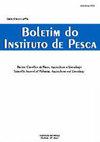赤道大西洋深海延绳渔具三种饵料的比较分析
IF 0.6
4区 农林科学
Q4 FISHERIES
引用次数: 0
摘要
诱饵的选择是一种渔业策略,用来增加对特定目标物种的选择性。利用在赤道大西洋作业的商船,采用深海延绳钓法对大黄鳍金枪鱼和大眼金枪鱼进行了三种饵料(鲭鱼、沙丁鱼和鱿鱼)的性能评价。通过广义线性模型(GLM)评价了不同因素和协变量对每努力捕获单位(CPUE)的影响。三种饵料共121套,共捕获黄鳍金枪鱼1166条,大眼金枪鱼1219条。结果表明,对每个目标物种的鱼饵类型有偏好,黄鳍金枪鱼主要被鱿鱼鱼钩捕获,大眼金枪鱼用鲭鱼鱼饵捕获。对鱼钩三个深度范围的结果进行分层分析,黄鳍金枪鱼鱼饵与深度的组合使鲭鱼在中间深度层的捕获概率增加。对于大眼金枪鱼,在中间层使用鲭鱼会降低捕捞率。副渔获量约占总渔获量的11.15%。这些结果将为选择最有效的远洋延绳钓鱼饵提供重要信息,并有助于今后渔业管理的决策。本文章由计算机程序翻译,如有差异,请以英文原文为准。
Comparative analysis of three bait types in deep-set pelagic longline gear in the Equatorial Atlantic Ocean
The choice of bait is one of the fisheries tactics used to increase selectivity for particular target species. The performance of three bait types (mackerel, sardine, squid) was evaluated with a commercial vessel operating in the Equatorial Atlantic Ocean using the deep-set pelagic longline deployment method to target large yellowfin and bigeye tunas. The effect of different factors and covariates on the Capture per Effort Unit - CPUE was evaluated through Generalized Linear Models (GLM). In 121 experimental sets using three bait types, 2385 individuals of the two target species were captured, 1166 yellowfin tuna and 1219 bigeye tuna. The results suggest a preference between bait types for each target species, with the yellowfin tuna being mostly caught by the hooks using squid and bigeye tuna with fish bait mackerel. Stratifying the results for three depth ranges of the hooks, the combination of bait and depth for yellowfin tuna resulted in an increase of catch probability in the intermediary depth layer using mackerel. For bigeye tuna, using mackerel in the intermediary layer resulted in a reduction in the catch rate. Bycatch represented around 11.15% of total captures. These results will provide important information to choosing the most efficient bait for the pelagic longline fishing operation and will help future decisions of fisheries management.
求助全文
通过发布文献求助,成功后即可免费获取论文全文。
去求助
来源期刊

Boletim do Instituto de Pesca
FISHERIES-ZOOLOGY
CiteScore
0.80
自引率
0.00%
发文量
24
审稿时长
>12 weeks
期刊介绍:
To publish original articles of research and short communications in the following áreas: Fisheries, Aquaculture, Zootechnology, Limnology, Oceanography, Biology and Pathology of aquatic organisms. The publication depends on the approval of the Editorial Board, based on the peer review.
 求助内容:
求助内容: 应助结果提醒方式:
应助结果提醒方式:


